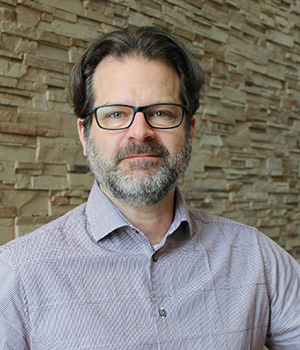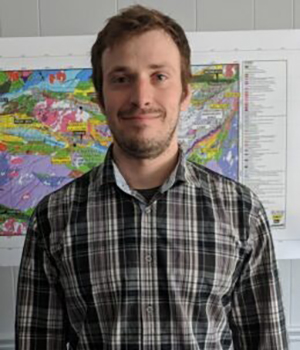Back to program
Gold Mineralization: A Matter of Timing!
Tuesday, November 19, 2024
Room 303AB - SOQUEM
Gold remains a pillar of exploration and mining in Quebec, and this technical session focuses on the geological and structural framework, supported by geochronological and geochemical methods, to constrain issues related to the controls and timing of gold mineralization. Notably, several deposits in both emerging and mature areas indicate that pre-Timiskaming mineralization occupies an important place in the Abitibi gold budget.
The speakers will present the results of their research to further our understanding of the indices leading to the resolution of the mineralization sequence of several belts in Quebec. The different approaches proposed could modulate our understanding of key events and warrant greater attention to the fine details of gold zones.
This session will be offered in French and in English.
9:30 a.m.
Welcome Address
9:40 a.m.
Pre-timiskaming Structurally Controlled Gold Systems of the Norbenite-Marbenite Tectonic, Magmatic, and Hydrothermal Corridor: An Important Episode in the Abitibi Greenstone Belt Gold Metallogeny
Conference details
The bulk of the gold in the Abitibi is either syn-volcanic (≥2695 Ma) or associated with the main phase of regional N-S shortening (referred to as D3 deformation) and hosted in orogenic gold deposits. Orogenic gold deposits (sensu stricto), although difficult to date precisely, are syn-D3 (~2660−2640 Ma). There is however a significant amount of gold in the southern Abitibi that is hosted in a group of deposits that postdate volcanism (≤2695 Ma) but predate D3 (≥2660) and the associated main phase of orogenic-type gold mineralization. Although pre-D3, these deposits are controlled by structural features associated with early phases of deformation and are commonly associated with small calc-alkaline intrusive bodies comprising diorite, monzonite, granodiorite, quartz monzonite and granite. They also vary significantly in style, have a subtle hydrothermal alteration footprint relative to other gold deposit types, are strongly deformed and metamorphosed, and are locally overprinted by orogenic-type gold. Previous work and new results from this study indicate that these deposits, common in the Norbenite-Marbenite Corridor (Val-d’Or-Malartic district) were formed between ~2695 Ma and ~2685 Ma and are associated with the early phase(s) of deformation (D1 and/or D2), more specifically with faults that are preferentially located along contacts between mafic and ultramafic volcanic units, or within Fe-rich basalts or near their contacts. Kiena, Marban, Norlartic, Orion, and the recently discovered and now actively mined South Zones at the Goldex mine are part of this group of early structurally controlled gold vein systems.
The South Zones veins, used in this presentation as a case study, are cut by 2685 Ma (post-volcanic, pre-Timiskaming) calc-alkaline dykes and were overprinted by D3. The veins have native gold within amphibole porphyroblasts, amphibole porphyroblasts within sulphide aggregates, and show high-temperature dynamic quartz recrystallization and metamorphic replacement of pyrite by pyrrhotite.
The South Zones (and the other deposits mentioned above) offer new insights into early deformation (D1 or D2) and metallogenesis in the southern Abitibi and attest to the importance and protracted history of the Marbenite-Norbenite Structural Corridor as a gold metallotect. Such deposits could be more common than currently thought, representing a knowledge gap in our genetic and exploration models for gold in the Abitibi, and perhaps in other greenstone belts.
10:00 a.m.
Primary Structural Framework of the Windfall Gold Deposit: Preliminary Results From a Detailed Volcanic Reconstruction and Implications for Metallogenesis
Conference details
A robust geological and structural framework of host rocks is critical to resolve the timing and genesis of gold (or any ore) deposits. This is particularly important for complex or enigmatic styles of mineralization in polydeformed and metamorphic settings. Building on recent and ongoing work, detailed geological, structural and geochronological studies were undertaken to refine the metallogenic model of the 7.4 Moz Windfall gold deposit (Urban-Barry Belt, Abitibi Subprovince).
The deposit is hosted in folded and faulted ca. 2718-2716 Ma tholeiitic to calk-alkalic intermediate to felsic volcanic and volcanoclastic sequences along the structural footwall of the SE-dipping Masères Deformation Zone. The assemblage is cut by gabbro sills and dykes (age[s] unknown) and a suite of ca. 2701-2699 Ma intermediate to felsic calc-alkalic dykes referred to as the Windfall Intrusive Complex (WIC). Gold is associated with pyrite-quartz-sericite stringer-style veins and quartz-pyrite replacement zones or veins that form (sub-) vertical, northeast-plunging ore zones. These veins are locally hosted in the WIC and therefore must be <2701 Ma. Previous studies have suggested a mineralization event contemporaneous with the WIC, but recent work reveals gabbro dykes cutting the latter are also mineralized. All host rocks and ore-associated veins and alteration are affected by the main phase of deformation. In the most endowed section of the Windfall deposit (Lynx zones), multiple sets of subvertical, northeast-trending breaks or faults have been identified for the first time in the volcanic package. Apparent normal and reverse displacements range from 10s to 100s of meters. Noteworthy, the area where fault offsets are substantial coincides with a high abundance of intermediate dykes of the WIC and with the bulk of the Lynx mineralization. Based on multiple markers, the timing of these structures is bracketed between ≤2716 Ma (i.e. synvolcanic) and the emplacement of a gabbro sill (age unknown but cut by the WIC; hence>2701 Ma). We postulate that the early primary structures defined by the development of (deeply rooted?) synvolcanic faults associated with an extension-induced felsic volcanic-filling basin may have acted as a conducive environment (e.g., crustal thinning, permeable conduits) for channelling later ascending magmas and fluids. If correct, the identification of pre-existing subsidence of intermediate to felsic volcanic edifices (even 10s of Ma older) could serve as an important vector for Windfall-like settings in the Urban-Barry Belt or elsewhere.
10:40 a.m.
Resolving the Stratigraphy, Age, and Metallogenic Implications of a Newly Identified Volcaniclastic Unit at the Windfall Gold Deposit, Northeast Abitibi Subprovince
Conference details
The Urban-Barry Belt, located in the eastern section of the Abitibi Subprovince, hosts several prospective gold projects, notably the 7.4 Moz Windfall gold deposit (WGD). The WGD is hosted in a deformed bimodal, tholeiitic to calk-alkalic volcanic assemblage of the ca. 2718-2716 Ma Macho Formation. Overlying this sequence in the northeast section of the deposit (Lynx zones) is a 300 m-thick calc-alkalic intermediate fragmental unit, whose age and origin had yet to be constrained. Crosscutting this ore-hosting volcanic sequence is a suite of ca. 2700 Ma calc-alkalic intermediate to felsic intrusions (collectively known as the Windfall Intrusive Complex: WIC), spatially associated with gold mineralization formed by subvertical, northeast plunging zones of quartz-pyrite±sericite stringers and veins.
To better understand the enigmatic calc-alkalic fragmental unit, detailed facies mapping was conducted on drill core across three vertical sections, complemented with whole-rock geochemistry and U-Pb zircon geochronology. The result from this detailed stratigraphic analysis shows four distinct facies, classified based on fragment abundance, morphology and type. Documented fragment types include: millimetric to centimetric tourmaline and pyrite fragments, variably quartz-phyric juvenile fragments, and variably quartz-phyric lithic fragments, which are likely inherited from the stratigraphically underlying volcanic rocks of the Macho Formation. Based on textural and structural characteristics (e.g., bedding and graded sequences) and mappable, horizontal sub-conformable facies, a volcaniclastic origin is demonstrated. An initial U-Pb zircon age of ca. 2719 Ma, obtained through LA-ICP-MS, suggests that this fragmental unit is contemporaneous with Macho age volcanism, rather than the WIC. Whole-rock geochemical analysis shows variability that is strongly controlled by the presence and proportion of juvenile and lithic fragments, which effectively act as compositional end members. This fragmental unit was first observed within the footprint of the WGD and has subsequently been found along the Masères Structural Corridor. While no temporal link exists between this volcaniclastic unit and mineralization, its spatial proximity, unique texture, and evidence of early hydrothermal activity (e.g., tourmaline and altered volcanic fragments) leads us to hypothesize that this unit may have acted as an important ground preparation step for the younger mineralization event.
11:00 a.m.
Geologic Setting, Style and Chronology of Gold Mineralization in the Detour-Harricana-Turgeon Belt, NW Abitibi Greenstone Belt
Conference details
The Harricana-Turgeon Volcano-Sedimentary Belt, the most northwestern belt in the Abitibi, spans about 90 km E-W, crosses the provincial border between Ontario and Quebec, and is mostly covered in glacio-lacustrine sediments, limiting geological interpretation and exploration. The belt’s tectonostratigraphy, structural evolution, age of rock units and regional correlations are not well established. The belt is transected by the Sunday Lake Deformation Zone, a major brittle-ductile deformation corridor, which is spatially associated with significant gold occurrences including the Detour Lake Mine (~15 Moz reserves), the Martiniere gold deposit (~1.3 Moz), and the recently expanded Fenelon deposit (4.1 Moz). Previous work concluded that this region shares many characteristics with the southern Abitibi’s gold-producing districts, including similar major E-W trending deformation zones delineating sedimentary basins and marked by polymictic conglomerate, calc-alkaline intrusions, and various mineralization and alteration styles. This presentation will provide the state of knowledge on the belt and its major gold occurrences with an emphasis on Fenelon, a deposit that is atypical compared to the quartz-carbonate vein deposits of southern Abitibi. Fenelon has spatial and temporal association with calc-alkaline intrusions and an enrichment in sulphides and certain elements, characteristics which are similar to intrusion-related gold deposits. Two hypotheses are being tested: Fenelon is an intrusion-related deposit that was buried and nearly wholly remobilized into ductile structures, or a hybrid deposit type in which magmatic fluids were released at depth within an early orogenic stage.
11:20 a.m.
Is Matagami gold a victim of zinc?
Conference details
The Matagami Camp in Quebec is well known to the mining industry for his history as a major zinc producer. The camp’s 12 mines have produced over 57 Mt of ore at an average grade of 8.77% Zn, 0.89% Cu, 24.79 g/t Ag and 0.46 g/t Au. Discovered in 1957 through drilling targeting an airborne geophysical anomaly, the Lac Mattagami mine went into operation only 5 years later, in 1962. The richness and abundance of the massive sulphide deposits, coupled with the expertise of geophysicists and geologists, enabled almost continuous operation over a 60-year period until the Bracemac-McLeod mine closed in 2022, with only 4 years without a production history.
Unlike other major base metals (Cu, Zn) mining camps, such as Rouyn-Noranda, Val-d’Or or Timmins, the Matagami camp has not seen any gold production as main occurrences. Certain questions arise to explain this absence. Could the discovery history of zinc deposits, their characteristics and the methods used to have had a negative influence on the search for and discovery of gold? Is the geological and structural context favorable or unfavorable to the presence of gold deposits? What type of gold deposit might be found in a favorable context?
The aim of this presentation is to answer these questions by relating publicly available information to the various vectors that have guided exploration of the camp over the past decades. This exercise demonstrates that the Matagami camp is no different from other camps, and that its gold potential is real.
11:40 a.m.
End of the session






